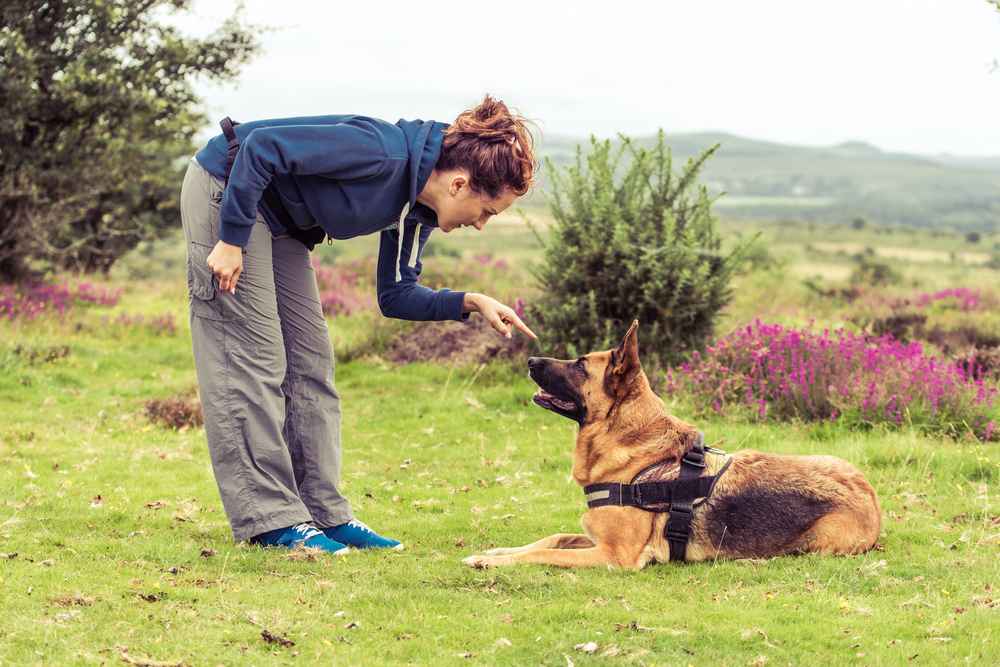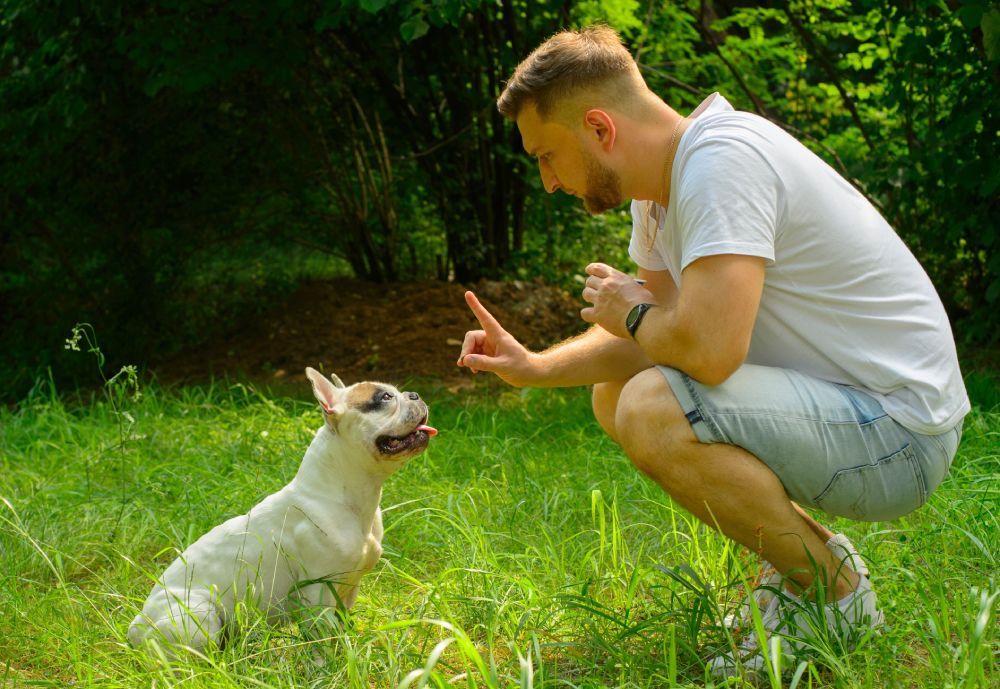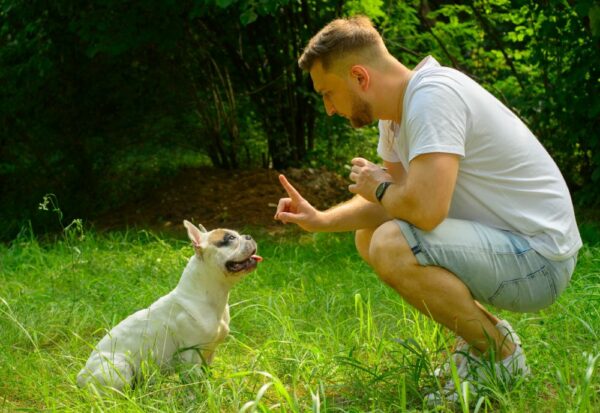There are a few basic commands that every dog should know. After learning to sit, the next step is often teaching your dog to lie down.
Laying down is an exceptionally practical command, and it’s necessary for many other commands. Commands like “stay” can also benefit from your dog already knowing how to lay down on command.
Luckily, teaching your dog to lie down isn’t challenging. However, we recommend that they already know how to sit on command. Once your dog can sit on command at least most of the time, you can move on to the lie-down command while continuing to practice sitting, of course.

The Step-by-Step Guide for Teaching Your Dog to Lie Down
1. Get Your Dog’s Attention
Before you begin teaching the command, you need to get your dog’s attention. Preferably, you should be using treats (unless your dog is already clicker trained, and then your clicker will suffice). Call your dog’s name and shake the treat bag to get their attention.
At this point, your dog should already be used to training. After all, they should already know how to sit. However, if it’s been a while, you may need to give some extra prompting by waving the treats around to get your dog’s attention.
If you want to make the process even easier, we recommend teaching the attention command. This command lets your dog know that you’re about to tell them something, and it can make giving commands amidst the distractions of the real world much easier.

2. Start with Sitting
Once your dog is paying attention, tell them to sit. If they’re still mastering this command, consider practicing a few times before introducing the new command.
While you can, technically, teach a dog to lie down before they know how to sit, this process is more challenging. Plus, the sit command is used as the starting point for several other commands, too. It makes sense to teach your dog the sit command first for this reason.
3. Lure them Down
After putting your dog in the sit position, gently hold the treat in front of their nose. Don’t put it so close that they reach out to grab it, but they should absolutely know where the treat is. Next, move the treat towards the floor slowly. Once you reach the floor, make sure your dog has enough room to actually lay down. It shouldn’t be right between their front paws, for instance.
Your dog should follow the treat with their eyes and nose. In a perfect world, every dog would lie down once the treat hits the floor. However, this typically isn’t what we experience, especially the first time you practice it.
At first, your dog will have no idea what you want, and they’ll likely just try to lean down and take the treat from you. If your dog doesn’t lie down once the treat is on the floor, cover it with your hand. Most will lay down now in an attempt to shove their nose underneath your hand. You’ll likely have to do this the first few times you lure your dog. After that, they should get the memo!
If your dog still isn’t laying down, double-check that you’re giving them enough room. Give them a bit of encouragement by patting the floor and giving them some encouraging rewards.
As soon as your dog’s elbows hit the ground, reward them with the treat and praise them!

4. Introduce the Cue
We recommend introducing the lie-down cue right away. On the very first lure, you should say the word “down.” Your dog should quickly begin to associate your cue with the command, eliminating the need for the lure. However, you’ll likely find yourself luring your canine for several sessions.
You can technically use any word for the cue that you want. The only requirement is that it shouldn’t sound like any other word your dog knows. That includes words that aren’t commands, like your dog’s name, and words like “treat.” Some dogs are better at differentiating words than others. However, it helps all dogs if you keep words as different as possible.
Keep practicing with the cue and lure for several sessions. Then, you can move on to the next step.
5. Fade to Lure
You don’t want your dog to require a lure to do the command. Therefore, you need to fade out the lure. In the beginning, this means you may not lure your dog all the way. Once your dog seems to understand the command, start by luring only halfway down. Your dog should figure out what you want and go the rest of the way down (if they don’t, you need to practice more).
Keep decreasing the amount of movement you do to lure your dog until you can just say “down.” Once your dog lays down without any luring and looks at you excitedly for a treat, it’s time to move on.

6. Fade the Reward
You don’t want to carry treats around with you constantly, either. Just like we faded the lure, you’ll need to fade the reward.
Start by rewarding your dog with treats only every other time they successfully do the command. However, you should still praise them verbally. Once your dog is used to only getting treats some of the time, you can fade out the reward even more. Eventually, you should only rarely reward your dog with treats.
Many people skip this step, as your dog will seem like they’ve mastered the command before you complete it. However, not fading out the reward leaves you reliant on treats, which means that your dog might not listen to you in the real world when treats aren’t available.

Tips for Successful Training
- Keep training sessions short and positive. In many cases, 5 minutes is plenty, especially for dogs new to training (and if your dog is learning this command, they are probably still in that “new” category). Slowly work up to 10 minutes as your dog is able.
- Patience and consistency should be your primary focus during training. Learning takes time, even for smarter breeds.
- Always finish your training sessions on a high note. Finish training before your dog gets tired, and don’t use the last minute of a session to try something really hard.
- Use positive reinforcement training for the best results. Many dogs respond very well to treats and praise, so rely on them heavily during training.

Final Thoughts
Training your dog to lie down isn’t challenging. However, it does require a lot of patience and consistency. Getting your dog to lie down with a treat lure is only the first step. You have to implement a cue and fade out luring and rewards. This process can take several weeks, but every step is necessary if you want your dog to lie down on command.
Once your dog has mastered this command, it’s time to move on to the other basic commands, such as “stay.”
Don’t forget to practice with distractions, too. Your dog will probably not focus well when other people and dogs are around. Many dogs have a hard time even paying attention outside. Be sure to implement training that helps your dog overcome distractions alongside teaching specific cues.
Featured Image Credit: Serhii Yushkov, Shutterstock









